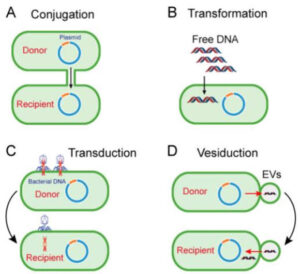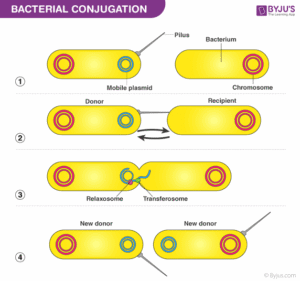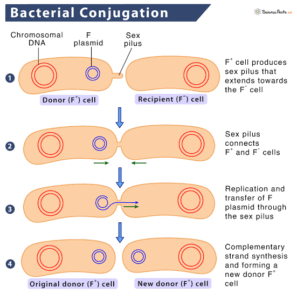Back to: MICROBIOLOGY 100 LEVEL
Welcome to class!
Hey bright star! It’s so wonderful to see you here again. You’re becoming a true microbiologist-in-the-making, and today’s lesson is another exciting step forward. We’re talking about Conjugation, Transformation, and Transduction—three ways bacteria share and exchange genetic information. Imagine bacteria as smart little neighbours who love to gossip and pass secret notes. Let’s break it all down in a way that makes perfect sense.
Conjugation, Transformation, And Transduction
Conjugation
Conjugation is like a bacterial handshake that transfers genetic material from one cell to another. One bacterium (called the donor) connects to another (the recipient) using a tiny, hair-like structure called a pilus.

What’s shared? A plasmid—a small loop of DNA that often carries useful traits, like antibiotic resistance.
Imagine two friends in class. One has a secret formula for solving maths problems (the plasmid). They stretch out a straw (the pilus), pass a folded note through it, and now both of them know the trick!
Key points about conjugation:
Requires direct contact between bacteria.
Only works when the donor has a special plasmid called the F (fertility) plasmid.
It helps bacteria adapt quickly to new environments.
Transformation
Transformation is when a bacterium picks up free DNA from its environment—usually from other bacteria that have died and burst open.

Think of it like recycling. A smart bacterium finds valuable DNA lying around and decides to keep it and use it!
Picture a student walking through a classroom and seeing old notes left on a desk. They pick it up, read it, and now they know something new without anyone teaching them!
Key points about transformation:
No contact between cells is needed.
The new DNA becomes part of the bacterium’s genome.
It helps bacteria gain new traits like resistance or better survival skills.
Transduction
Transduction involves a virus that infects bacteria—called a bacteriophage. This virus accidentally carries a piece of one bacterium’s DNA and inserts it into another bacterium when it infects it.
It’s like a delivery gone wrong—the virus meant to bring trouble but ends up dropping a surprise gift.
A delivery guy picks up a package from House A, but by mistake, he drops it at House B. House B opens the package and finds useful information!

Key points about transduction:
Carried out by viruses.
Transfers DNA between bacteria without direct contact.
Can result in useful genetic changes.
Summary
- Conjugation: Bacteria share DNA directly through a pilus.
- Transformation: Bacteria take in free DNA from the environment.
- Transduction: Viruses move DNA from one bacterium to another by accident.
- All three methods help bacteria evolve, share traits, and adapt quickly.
Evaluation
- What is the main structure used in bacterial conjugation?
- How is transformation different from conjugation?
- What role do viruses play in transduction?
- Give a real-life example that explains transformation.
- Why are these processes important to bacteria?
What you’ve just learned helps explain why bacteria can become so powerful and resistant. With knowledge like this, you’re becoming someone who can make a real difference in health and science. Keep going—Afrilearn is always here to cheer you on!
